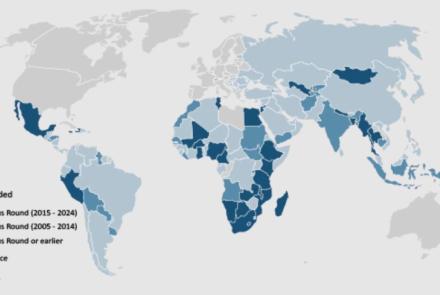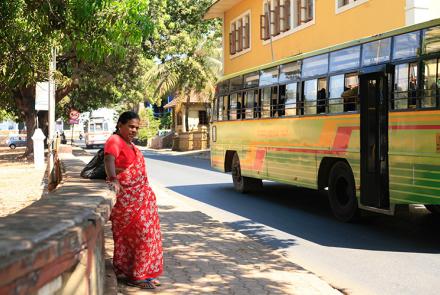Annotated Bibliography: Women's Autonomy, Agency and Control Over Resources
Agarwal, B. (1994). Gender and command over property: A critical gap in economic analysis and policy in South Asia. World Development, 22(10), 1455-1478.
This paper focuses on a much-neglected issue: the links between gender inequities and command over property. It outlines why in rural South Asia, where arable land is the most important form of property, any significant improvement in women’s economic and social situation is crucially tied to their having independent land rights. Better employment opportunities can complement but not substitute for land. But despite progressive legislation few South Asian women own land; even fewer effectively control any. Why? A complex range of factors - social, administrative, and ideological - are found to underlie the persistent gap between women’s legal rights and their actual ownership of land, and between ownership and control. The necessity of collective action by women for overcoming these obstacles and the aspects needing a specific focus for policy and action are also discussed.
Agarwal, B. (1997). Bargaining and gender relations: Within and beyond the household. Feminist Economics, 3(1), 1-51.
Highlighting the problems posed by a “unitary” conceptualization of the household, a number of economists have in recent years proposed alternative models. These models, especially those embodying the bargaining approach, provide a useful framework for analyzing gender relations and throwing some light on how gender asymmetries are constructed and contested. At the same time, the models have paid inadequate or no attention to some critical aspects of intra-household gender dynamics, such as: What factors (especially qualitative ones) affect bargaining power? What is the role of social norms and social perceptions in the bargaining process and how might these factors themselves be bargained over? Are women less motivated than men by self-interest and might this affect bargaining outcomes? Most discussions on bargaining also say little about gender relations beyond the household, and about the links between extra-household and intra-household bargaining power. This paper spells out the nature of these complexities and their importance in determining the outcomes of intra-household dynamics. It also extends the bargaining approach beyond the household to the interlinked arenas of the market, the community and the State.
Anderson, C. L., Reynolds, T. W., & Gugerty, M. K. (2017). Husband and wife perspectives on farm household decision-making authority and evidence on intra-household accord in rural Tanzania. World Development, 90, 169-183.
We use OLS and logistic regression to investigate variation in husband and wife perspectives on the division of authority over agriculture-related decisions within households in rural Tanzania. Using original data from husbands and wives (interviewed separately) in 1,851 Tanzanian households, the analysis examines differences in the wife’s authority over 13 household and farming decisions. The study finds that the level of decision-making authority allocated to wives by their husbands, and the authority allocated by wives to themselves, both vary significantly across households. In addition to commonly considered assets such as women’s age and education, in rural agricultural households women’s health and labor activities also appear to matter for perceptions of authority. We also find husbands and wives interviewed separately frequently disagree with each other over who holds authority over key farming, family, and livelihood decisions. Further, the results of OLS and logistic regression suggest that even after controlling for various individual, household, and regional characteristics, husband and wife claims to decision-making authority continue to vary systematically by decision—suggesting that decision characteristics themselves also matter. The absence of spousal agreement over the allocation of authority (i.e., a lack of ‘‘intra-household accord”) over different farm and household decisions is problematic for interventions seeking to use survey data to develop and inform strategies for reducing gender inequalities or empowering women in rural agricultural households. Findings provide policy and program insights into when studies interviewing only a single spouse or considering only a single decision may inaccurately characterize intra-household decision-making dynamics.
Anderson, S., & Eswaran, M. (2009). What determines female autonomy? Evidence from Bangladesh. Journal of development economics, 90(2), 179-191.
This paper examines the determinants of female autonomy within households in a developing country. In particular, we investigate the relative contributions of earned versus unearned income in enhancing women's autonomy and the role of employment outside of their husband's farm. In a simple theoretical model, it is demonstrated that earned income could be more important than unearned income in empowering women. Using data from rural Bangladesh, empirical estimations confirm this prediction and also reveal the surprising fact that it is not employment per se but employment outside their husbands' farms that contributes to women's autonomy. The data also point to the importance of choosing the correct threat point in theoretical analyses of female autonomy.
Chang, W., Díaz-Martin, L., Gopalan, A., Guarnieri, E., Jayachandran, S., & Walsh, C. (2020). What Works to Enhance Women’s Agency: Cross-Cutting Lessons From Experimental and Quasi-Experimental Studies. J-PAL Working Paper.
Women’s agency continues to be limited in many contexts around the world. Much of the existing evidence synthesis focuses on one outcome or intervention type, bracketing the complex, overlapping manner in which agency takes shape. This review adopts a cross-cutting approach to analyzing evidence across different domains and outcomes of women’s agency and focuses on understanding the mechanisms that explain intervention impacts. Drawing from quantitative evidence from 160 randomized controlled trials and quasi-experiments in low- and middle-income countries, we summarize what we know about supporting women’s agency along with what needs additional research.
Fakir, A. M., Anjum, A., Bushra, F., & Nawar, N. (2016). The endogeneity of domestic violence: Understanding women empowerment through autonomy. World development perspectives, 2, 34-42.
Women’s autonomy is known to incite intimate partner violence (IPV) in developing countries. We argue for the endogeneity of women’s autonomy with IPV, which is often ignored in the existing literature, for understanding the causal association. Using the Bangladesh Demography and Health Survey (2007), we isolate the effect of autonomy on IPV taking into account the possible endogeneity using instrument variables and special regressor estimations, proposing the special regressor as a more reliable approach to estimating binary choice models with discrete endogenous regressors. Our study finds increased women’s autonomy to lead to higher incidents of IPV for a South Asian patriarchal society such as Bangladesh. Thereby, policies catered towards women empowerment by increasing women’s autonomy should concurrently focus on other determinants of IPV. Undue male controlling behaviour, witnessing inter-parental abuse as a child and early marriage are also found to aggravate IPV. Hence there should be simultaneous programmes that aim to relax male controlling behaviour over women, provide counselling for those who have witnessed inter-parental abuse as a child, and laws prohibiting child marriage, still prevalent in South Asian societies, should be reinforced. These findings have strong policy implications suggesting the dual nature of improving women’s autonomy in empowering women while aggravating IPV.
Gammage, Sarah, Naila Kabeer, and Yanavan der Meulen Rodgers. 2016. “Voice and Agency: Where are We Now?” Feminist Economics 22(1): 1–29.
This article examines how scholarship in feminist economics has developed and used evolving definitions of voice and agency, analyzing their expressions in the key domains of households, markets, and the public sphere. It builds on a rich body of work that explores the voice and agency of women and girls using bargaining theory, as well as behavioral and experimental economics, to understand inequalities in power and agency in relation to different institutional domains and socioeconomic processes. It also discusses each study in this volume, highlighting their contributions and drawing attention to critical gaps that remain in the literature.
Ghuman, S. J., Lee, H. J., & Smith, H. L. (2006). Measurement of women’s autonomy according to women and their husbands: Results from five Asian countries. Social Science Research, 35(1), 1-28.
We illustrate the difficulty of measuring gender relations in surveys by comparing couple responses to survey items on the wife’s autonomy in various domains using data from 23 com- munities in India, Pakistan, Malaysia, Philippines, and Thailand. We employ an item response model to show that the level of women’s autonomy depends on whether wives or husbands are respondents and that the response categories do not have the same cognitive or semantic meanings to men and women. The disagreement between men and women varies across communities for reasons that are not easy to explain. The items also contain random measurement error that attenuates the correlation between spousal reports. We conclude that these survey questions are of limited utility for understanding differences in gender stratification across context.
Hanmer, L., & Klugman, J. (2016). Exploring Women's agency and empowerment in developing countries: where do we stand? Feminist Economics, 22(1), 237-263.
While central notions around agency are well established in academic literature, progress on the empirical front has faced major challenges around developing tractable measures and data availability. This has limited our understanding about patterns of agency and empowerment of women across countries. Measuring key dimensions of women’s agency and empowerment is complex, but feasible and important. This paper systematically explores what can be learned from Demographic and Health Survey (DHS) data for fifty-eight countries, representing almost 80 percent of the female population of developing countries. It is the first such empirical investigation. The findings quantify some important correlations. Completing secondary education and beyond has consistently large positive associations, underlining the importance of going beyond primary schooling. There appear to be positive links with poverty reduction and economic growth, but clearly this alone is not enough. Context specificity and multidimensionality mean that the interpretation of results is not always straightforward.
Ibrahim, S., & Alkire, S. (2007). Agency and empowerment: A proposal for internationally comparable indicators. Oxford Development Studies, 35(4), 379-403.
This article proposes a short list of internationally–comparable indicators of individual agency and empowerment (and the corresponding survey questions). Data from these indicators would enable researchers to explore research and policy issues such as the interconnections between empowerment and economic or human development. The article surveys definitions of agency and empowerment, adopts the definition from Amartya Sen, supplemented by Rowlands’ typology. The proposed ‘short list’ of indicators includes; control over personal decisions; domain-specific autonomy; household decision-making; and the ability to change aspects in one’s life at the individual and communal levels. The strengths and weaknesses of each indicator are discussed, as is the need to supplement this shortlist with other variables. To ensure the feasibility of the proposal, we rely on previously-fielded questions wherever possible.
Jejeebhoy, S. (2000). Women's autonomy in rural India: Its dimensions, determinants, and the influence of context. In H. B. Presser & G. Sen (Eds.), Women's Empowerment and Demographic Processes: Moving Beyond Cairo (pp. 204-238). New York: Oxford University Press.
—Not available online—
Jejeebhoy, S. J. (2002). Convergence and divergence in spouses' perspectives on women's autonomy in rural India. Studies in family planning, 33(4), 299-308.
This study explores similarities and differences in the perceptions of rural Indian women and their husbands with regard to various dimensions of women's autonomy and investigates the extent to which various reproductive outcomes--contraception, unmet need, recent fertility, and spousal communication--are influenced by individual partners' views of women's autonomy. Data are drawn from a 1993-94 community-based study of women's autonomy in Uttar Pradesh and Tamil Nadu, states that are, respectively, more and less patriarchal. Matched data were obtained from 1,660 women and their husbands. Results indicate no more than a loose agreement between women and their husbands concerning the dimensions of women's autonomy within the home. Where disagreement is expressed, husbands are more likely to project a comparatively liberal picture of their wives' autonomy than do their wives, and the inference can be made that in surveys men tended to provide more "acceptable" responses than when they were questioned in greater depth. Findings also suggest that cultural context affects the influences that wives' and their husbands' perceptions of women's autonomy have on reproductive outcomes. A clear regional divide is seen, net of individual and household characteristics, in the influence of almost every aspect of women's autonomy.
Mason, K. O. (1996). Wives' economic decision-making power in the family in five Asian countries: East-West Center.
This chapter explores the impact of social context on the internal division of power in families in five Asian countries. Like most enduring human groups, families are never entirely egalitarian. The extent to which they are characterized by unequal decision- making power, however, varies enormously in time and space. Variation among family systems in decision-making inequality can have important consequences for the way in which the family's resources are distributed and hence for the health, survival, human capital, and happiness of family members. Although decision-making inequality in families may vary because of the ways in which resources are distributed in particular settings, enduring social traditions about the rights of women and men and those of senior and junior generations also are important. This chapter focuses on community and national contexts as determinants of wives' domestic power in the economic sphere in South and Southeast Asia. The impact of individual traits and household characteristics is also considered.
Nussbaum, M. (1995). Human capabilities, female human beings. Women, culture and development: A study of human capabilities, 61-104.
Nussbaum argues that the best way to tackle the issue of women's equality in developing countries is to begin with a conception of the human being and human functioning. By seeing certain capabilities and functions as more central to human life than others, Nussbaum anticipates feminist and cultural relativistic challenges and defends her particular brand of universalism and essentialism. This paper provides a self‐consciously normative c onception of what it is to be human and to live a good life, as well as a proposal for a culturally sensitive development ethic.
Nussbaum, M. C. (2001). Women and human development: The capabilities approach (Vol. 3): Cambridge University Press.
In this major book Martha Nussbaum, one of the most innovative and influential philosophical voices of our time, proposes a kind of feminism that is genuinely international, argues for an ethical underpinning to all thought about development planning and public policy, and dramatically moves beyond the abstractions of economists and philosophers to embed thought about justice in the concrete reality of the struggles of poor women. Nussbaum argues that international political and economic thought must be sensitive to gender difference as a problem of justice, and that feminist thought must begin to focus on the problems of women in the third world. Taking as her point of departure the predicament of poor women in India, she shows how philosophy should undergird basic constitutional principles that should be respected and implemented by all governments, and used as a comparative measure of quality of life across nations.
Osamor, P. E., & Grady, C. (2016). Women’s autonomy in health care decision-making in developing countries: a synthesis of the literature. International journal of women's health, 8, 191.
Autonomy is considered essential for decision-making in a range of health care situations, from health care seeking and utilization to choosing among treatment options. Evidence suggests that women in developing or low-income countries often have limited autonomy and control over their health decisions. A review of the published empirical literature to identify definitions and methods used to measure women’s autonomy in developing countries describe the relationship between women’s autonomy and their health care decision-making, and identify sociodemographic factors that influence women’s autonomy and decision-making regarding health care was carried out. An integrated literature review using two databases (PubMed and Scopus) was performed. Inclusion criteria were 1) publication in English; 2) original articles; 3) investigations on women’s decision-making autonomy for health and health care utilization; and 4) developing country context. Seventeen articles met inclusion criteria, including eleven from South Asia, five from Africa, and one from Central Asia. Most studies used a definition of autonomy that included independence for women to make their own choices and decisions. Study methods differed in that many used study- specific measures, while others used a set of standardized questions from their countries’ national health surveys. Most studies examined women’s autonomy in the context of reproductive health, while neglecting other types of health care utilized by women. Several studies found that factors, including age, education, and income, affect women’s health care decision-making autonomy. Gaps in existing literature regarding women’s autonomy and health care utilization include gaps in the areas of health care that have been measured, the influence of sex roles and social support, and the use of qualitative studies to provide context and nuance.
Ramu, G. N. (1988). Wife’s Economic Status and Marital Power: A Case of Single-and Dual- Earner Couples. Sociological Bulletin, 37(1-2), 49-69.
The main objective of this paper is to explore the extent to which the wife's co-provider's role has enabled her to share power in decision making. In the following sections, we propose to establish two points. First, that although traditionally, Indian women retained indirect influence, the newly achieved economic status by urban middle class women has contributed to their legitimate overt assertion of authority in domestic decisions. Second, contribution of women to family economy has helped their marriages to become slightly more egalitarian. A perspective for an understanding of marital power in India precedes the presentation of details on sample, methods, and findings. The findings suggest that wife's economic status is an important factor in domestic decision- making. When women lack monetary resources to bargain for power they either use covert influence to determine the outcome of a decision or subordinate themselves to their husbands' domination.




